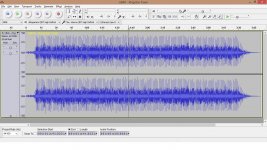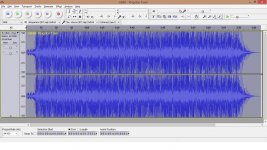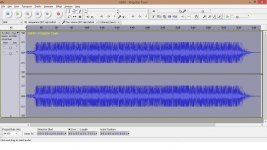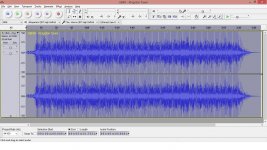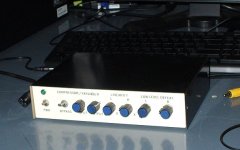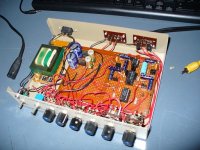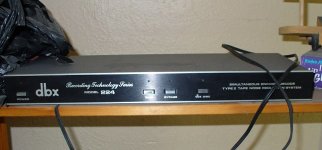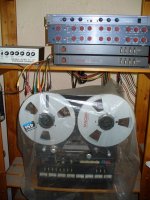If you tested it with a source recording then clipped it and uncompressed it the original looked identical to the uncompressed one.
In all honesty though i don't think it changes the sound at all. In my tests clipping the audio and keeping it with peaks you can't tell a difference with an ABX test and the two are level matched.
>>>>
foo_abx 2.0.1 report
foobar2000 v1.3.8
2015-09-02 23:56:53
File A: Naturally 7 - Feel It (In the Air Tonight) Normalized -10dB Declipped.flac
SHA1: b369a851cd1b51b87d47853e94ec2ab934f0f7ba
File B: Naturally 7 - Feel It (In the Air Tonight) Normalized -10dB.flac
SHA1: 9ed2b6a57965be05574330c6bfde1e7f7f6e936b
Output:
ASIO : ASIO 2.0 - ESI Juli@
Crossfading: NO
23:56:53 : Test started.
23:57:49 : 01/01
23:59:15 : 01/02
00:00:31 : 01/03
00:02:07 : 02/04
00:03:02 : 02/05
00:04:01 : 03/06
00:04:53 : 03/07
00:06:06 : 03/08
00:07:43 : 04/09
00:08:38 : 05/10
00:09:26 : 06/11
00:10:57 : 06/12
00:14:27 : 07/13
00:15:20 : 08/14
00:17:18 : 09/15
00:18:03 : 10/16
00:18:03 : Test finished.
----------
Total: 10/16
Probability that you were guessing: 22.7%
-- signature --
4ff0561e6ab30945b3196f8fe4e4e1e0a87c60fa
>>>>
Redrawing the peaks should sound about the same in my experience.
With anything like this when comparing things you MUST perceptually level match the two you are comparing or you might think you are hearing something that is simply just an increase in volume.
Absolutely not... volume it's not the same as dynamics... and most of all DISTORTION.
Clipping adds a lot of distortion, particularly for bass lines and high frequency details.
The song I've used to do the ABX test has an hard bass and difference it's pretty obvious, and it's real, like the ABX test demonstrate.
How did you clip it? I don't exactly know the signal chain. Maybe i should go back and test again. I just did it similar to how a mastering engineer did it and didn't do any sort of unmastering. Level match the "mastered" one perceptually with the one that hasn't been mastered. You went through an extra step i would not have done which may add a layer of distortion for all i know.
I sort of gave all of this up when i started making my masters in 32-bit float. 32-bit float i think you can exceed digital 0 and just turn the volume back down and the peaks are still there - the software visuals just lie.
I sort of gave all of this up when i started making my masters in 32-bit float. 32-bit float i think you can exceed digital 0 and just turn the volume back down and the peaks are still there - the software visuals just lie.
How did you clip it? I don't exactly know the signal chain.
I've taken the opposite path... I've declipped a commercial song.
The track has been first normalized to -10 dB, then 2 copies have been saved with dithering for 16 bit applied (PsychoDither, red preset) one without further processing and one with the Stereo Tool Declipper only.
Maybe i should go back and test again. I just did it similar to how a mastering engineer did it and didn't do any sort of unmastering. Level match the "mastered" one perceptually with the one that hasn't been mastered. You went through an extra step i would not have done which may add a layer of distortion for all i know.
'De-mastering' commercial over compressed and clipped tracks is what this thread is all about...
I've also experimented compressing and clipping tracks with high dynamics and if done right with a light touch and the right software the limited track will sound very similar to the original one.
Quality decrease with increasing limiting.
A well mastered DR8-10 track will sound quite as good as a DR14 one, sadly this is not the case with most commercial tracks.
I sort of gave all of this up when i started making my masters in 32-bit float. 32-bit float i think you can exceed digital 0 and just turn the volume back down and the peaks are still there - the software visuals just lie.
No, it don't lie... while editing in the software 'overs' are preserved for further processing but they're gone once you export it as a single track.
There is no such thing as data over 0 dB in digital.
See the tests i did i was using my actual multi track masters for testing which allowed me to test if certain mastering practices are transparent or not. I just don't know what the signal chain is with what you are doing i guess. And what you could be possibly detecting is the distortion as a result of your demastering.
I did a few tests but i could be wrong. What i do is render directly from my multitrack in 32-bit float with the signal above 0dB. You then just import that track which looks clipped in a destructive audio editor and turn the volume down and walla the peaks are actually still there and the audio editor is actually lieing to you about it clipping. Try it.
The trick is that most people would want it to be in a playable bit depth before listening but to be honest i didn't expect many people to want anything other than an mp3 which has no bit depth and didn't seem to matter that i fed it a 32-bit float file that exceeded digital 0 for normal fixed bit depth.
I don't think digital meters are made for floating point bit depth.
I did a few tests but i could be wrong. What i do is render directly from my multitrack in 32-bit float with the signal above 0dB. You then just import that track which looks clipped in a destructive audio editor and turn the volume down and walla the peaks are actually still there and the audio editor is actually lieing to you about it clipping. Try it.
The trick is that most people would want it to be in a playable bit depth before listening but to be honest i didn't expect many people to want anything other than an mp3 which has no bit depth and didn't seem to matter that i fed it a 32-bit float file that exceeded digital 0 for normal fixed bit depth.
I don't think digital meters are made for floating point bit depth.
I did a few tests but i could be wrong. What i do is render directly from my multitrack in 32-bit float with the signal above 0dB. You then just import that track which looks clipped in a destructive audio editor and turn the volume down and walla the peaks are actually still there and the audio editor is actually lieing to you about it clipping. Try it.
Just did it again to show here in the thread.
Here's a very dynamic track (DR16)
amplified by 10dB
Amplified to -6dB, overs are still there, the software preserved it.
Then I've exported the track to 24bit Flac and opened it.
Amplified by -6dB, overs disappeared:
The trick is that most people would want it to be in a playable bit depth before listening but to be honest i didn't expect many people to want anything other than an mp3 which has no bit depth and didn't seem to matter that i fed it a 32-bit float file that exceeded digital 0 for normal fixed bit depth.
I don't think digital meters are made for floating point bit depth.
I think you're missing the point... digital meters means nothing here.
In digital there is nothing that can be represented over 0dB.
Let's say we're using 16 bit signed integer data, each sample is a number between -32768 and 32767.
-32768 and 32767 are 0dB, you can't simply represent 32768 or -32769, they simply will not 'fit'.
What you're doing is exporting to a format which represents 0 dB to a lower number than the maximum so that overs are preserved.
But the music you buy, even in HD formats, use the full scale of the sample so no overs are there, you can't simply amplify by a negative factor and expect to retrieve overs.
Even the editing software sends data to the DAC using the full sample resolution (so with no data over 0dB), otherwise you couldn't hear what you're actually doing on the final rendered data which will be sent to customers.
Attachments
I stumbled across this old thread while searching for options for my system and had to comment even though it's an old thread. As several folks here pointed out, the original topic would be dynamic range expansion, not declipping. I've been doing this sort of thing for years; in fact, I recently added a mix of old and new to my system to test-drive it. Results so far are good!
Reference was made earlier to the original DBX boxes (not the encode/decode noise reduction units). By the 80s Signetics had chips and (barely) enough diagrams and info to build something with them, which I did. I used the linear book regarding the NE570 chip (though I had the somewhat different NE572) and built one that worked so well I also built a knock-off while the memory was fresh in my mind. They work just like most any compressor/expander. The desired effect is applied by averaging the level of the signal over a given short time, comparing that to a zero-reference, and (depending on what's 'dialed in' on the front panel) mixing wet/dry signals to achieve the desired ratio of expansion (or compression). A low-level amplitude threshold is also dialable (to limit processing to levels above the noise floor).
I recently decided that I wanted to try something new. Having convinced myself that a direct radiator likely imparts some compression to sound in of itself (being far less than 100% efficient in both its mechanical transduction and its coupling to air, and compression being one artifact of inefficiency), I concluded that my horns and their compression drivers likely impart less unwanted compression due to their much lighter diaphragms and much-improved air coupling. At least that was the assumption. Since I haven't the room nor inclination to use bass horns, I decided to try a bit of dynamic expansion on the bass drivers only.
I wanted to do it in software, but found myself stymied by the fact that, following splitting the band on each stereo channel into 4 parts (for my 4-way speakers) through use of convolver-VST running in foobar2000, I had no way of piping only the two woofer streams through a software expander. Rather than try to find an instant solution, I thought of my long-unused NE572 box and dug it out, running the woofer outputs from the DAC through it. The results were excellent, after remembering how to set the device up. With just a bit of expansion dialed in, my bass suddenly had the 'punch' of my horns. I'm still looking for a palatable way to try doing this in software, but for now it's not urgent. I must say I did a heck of a job 30 years ago on that box! I've attached a couple of photos, I was so pleased at my own workmanship when I removed the cover to look at my long-unseen project.
Since then, though, I've also begun using a software expander (I'm currently using the ReaXcomp VST plugin on foobar, which may be used as an expander) to impart slight expansion to the entire band. With modest settings it not only brings some older recordings to life, it also seems to marginally improve even recent digital recordings of the BSO as streamed from the web. IMO expansion remains what it was in the 80s (though far easier to implement) as long as you use it wisely. A lot of compression can be used before the effects become obnoxious; with expansion it's much easier to overdo things.
Reference was made earlier to the original DBX boxes (not the encode/decode noise reduction units). By the 80s Signetics had chips and (barely) enough diagrams and info to build something with them, which I did. I used the linear book regarding the NE570 chip (though I had the somewhat different NE572) and built one that worked so well I also built a knock-off while the memory was fresh in my mind. They work just like most any compressor/expander. The desired effect is applied by averaging the level of the signal over a given short time, comparing that to a zero-reference, and (depending on what's 'dialed in' on the front panel) mixing wet/dry signals to achieve the desired ratio of expansion (or compression). A low-level amplitude threshold is also dialable (to limit processing to levels above the noise floor).
I recently decided that I wanted to try something new. Having convinced myself that a direct radiator likely imparts some compression to sound in of itself (being far less than 100% efficient in both its mechanical transduction and its coupling to air, and compression being one artifact of inefficiency), I concluded that my horns and their compression drivers likely impart less unwanted compression due to their much lighter diaphragms and much-improved air coupling. At least that was the assumption. Since I haven't the room nor inclination to use bass horns, I decided to try a bit of dynamic expansion on the bass drivers only.
I wanted to do it in software, but found myself stymied by the fact that, following splitting the band on each stereo channel into 4 parts (for my 4-way speakers) through use of convolver-VST running in foobar2000, I had no way of piping only the two woofer streams through a software expander. Rather than try to find an instant solution, I thought of my long-unused NE572 box and dug it out, running the woofer outputs from the DAC through it. The results were excellent, after remembering how to set the device up. With just a bit of expansion dialed in, my bass suddenly had the 'punch' of my horns. I'm still looking for a palatable way to try doing this in software, but for now it's not urgent. I must say I did a heck of a job 30 years ago on that box! I've attached a couple of photos, I was so pleased at my own workmanship when I removed the cover to look at my long-unseen project.
Since then, though, I've also begun using a software expander (I'm currently using the ReaXcomp VST plugin on foobar, which may be used as an expander) to impart slight expansion to the entire band. With modest settings it not only brings some older recordings to life, it also seems to marginally improve even recent digital recordings of the BSO as streamed from the web. IMO expansion remains what it was in the 80s (though far easier to implement) as long as you use it wisely. A lot of compression can be used before the effects become obnoxious; with expansion it's much easier to overdo things.
Attachments
Compander
Hi leoman, Maplin Electronics had a circuit for this! If memory serves me well. I think it was for cassette, bit like Dolby
Noise Reduction Unit (EMM May 81)
Hi leoman, Maplin Electronics had a circuit for this! If memory serves me well. I think it was for cassette, bit like Dolby
Noise Reduction Unit (EMM May 81)
Hi Deafuser, nice find! Looks like a 4-ch compander for noise reduction, probably for the simul-sync TEAC tape deck that was (sort of) popular for home recording etc. at the time. Looks like it's based on the NE570 (my thing's the 572). The article includes somewhat cryptic directions for using it as a compressor or expander rather than an encode/decode NR unit, but I think I'm glad now I used the Signetics book and wires! Probably cheaper too.
BTW I did home recording in that era, and the dbx noise redution compander units mentioned are familiar to me. The photos show one such 'home' unit using dbxII (whatever that meant), and the nearby remnants of some of the recording equipment which includes two 4-channel dbxI ('professional') NR units just over the Tascam 38 8-track deck they accompany. The results were crystal-clear and noiseless recordings (except for what I put on them).
The thing to the left of the dbxI boxes is the 'prototype' expander/compressor unit I made (obviously), essentially identical to the one shown in my prior comment. And yes, that thing on top of the stack is a real live Aphex Aural Exciter, Type C I got it at Sam Ash in NYC on one of my rare junkets there in 1986.
I got it at Sam Ash in NYC on one of my rare junkets there in 1986.
BTW I did home recording in that era, and the dbx noise redution compander units mentioned are familiar to me. The photos show one such 'home' unit using dbxII (whatever that meant), and the nearby remnants of some of the recording equipment which includes two 4-channel dbxI ('professional') NR units just over the Tascam 38 8-track deck they accompany. The results were crystal-clear and noiseless recordings (except for what I put on them).
The thing to the left of the dbxI boxes is the 'prototype' expander/compressor unit I made (obviously), essentially identical to the one shown in my prior comment. And yes, that thing on top of the stack is a real live Aphex Aural Exciter, Type C
Attachments
One addendum, in the spirit of the thread's actual subject matter... I did find a way to do my bass-only expansion in s/w. Cost $60, but after trying out MuLabs' trial version of MUX Modular VST I finally got it to cope with Convolver's mono channels (MUX defaults to stereo but supplies a pan control) and now have put my old expander back into hibernation, using ReaXcomp in its place. Everything is embedded now in MUX, which is the only VST that shows up in foobar's DSP stack. A VST into which you can load VSTs. Pretty cool. And it even works.
Also, I found that Antress Modern Expander is another great (free) dynamic range expander option; not that it matters, but it's a dedicated expander, not a compressor whose ratio can be set to less than 1:1.
Also, I found that Antress Modern Expander is another great (free) dynamic range expander option; not that it matters, but it's a dedicated expander, not a compressor whose ratio can be set to less than 1:1.
- Status
- This old topic is closed. If you want to reopen this topic, contact a moderator using the "Report Post" button.
- Home
- Source & Line
- PC Based
- Software that can "restore" some dynamics from overly compressed recordings?
